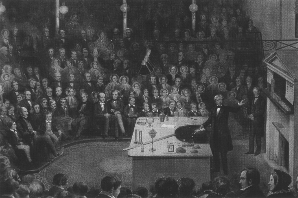
Natural Science - Year II
Unit 55: Rutherford and Atomic Structure

Science Weblecture for Unit 55
| This Unit's | Homework Page | History Lecture | Science Lecture | Lab | Parents' Notes |
Science Lecture for Unit 55: Atoms in Molecules
For Class
- Topic area: Quantum Mechanics and Chemical Bonds
- Terms and concepts to know: List
- See historical period(s): Twentieth Century atomic theory
Lecture:
Chemical Bonds
So what does this have to do with the chemical bond?
Molecules are groups of atoms which are held together by the interactions of their electrons. At the beginning of this course, we discussed the atom, and the 19th-century chemist's definitions of Ionic and covalent bonds. Now we have an explanation for the variation in bonding strengths and properties between atoms in different molecules. The position of the electron in one or the other possible orbital shells determines what kind of bonds the atom can form. Study the websites below for information on the types of bonds that form between atoms and molecules to form different substances.
Electrons in orbits
Read about electrons in atoms and the periodic table at the Chemistry Online! site. [2 long web pages]
Use the learning objectives as your questions for this site.
Chemical Bonds
Some of this material will be familiar to you from earlier units. Here we have a new perspective, looking at the divisible atom and its parts, and how each contributes to the relationship between atoms in molecules.
Read the explanation of atomic bonding at the Vision Learning site. Pay particular attention to the sections on the Modern Chemical Bond and Types of Chemical Bonds. (Most of this is review of concepts we discussed last fall.) Then review bonding and the types of bonds at the Hyperphysics site.
- What is a covalent bond? What makes some covalent bonds "polar"?
- What is an ionic bond?
- Which type of bond is strongest? weakest?
- Why does an electron move from one atom to another?
Metals
In solid metals, the nuclei are held together in a lattice arrangement. The electrons of the outer shells and some special inner shell electrons are free to move around and change places with electrons from other atoms. This freedom of motion explains the ability of metals to conduct heat and electricity readily; it also explains the tendency of metal to bend easily (its ductility and malleability).
Study/Discussion Questions
- How does the bond strength of a molecule affect its activity in a chemical reaction?
- What are the practical applications of knowing bond strength?
Further Study On your Own (Optional)
- A very graphics-oriented (and therefore slow to load) presentation on chemical bonds is available from the chemistry department at McMaster College.
© 2005 - 2024 This course is offered through Scholars Online, a non-profit organization supporting classical Christian education through online courses. Permission to copy course content (lessons and labs) for personal study is granted to students currently or formerly enrolled in the course through Scholars Online. Reproduction for any other purpose, without the express written consent of the author, is prohibited.